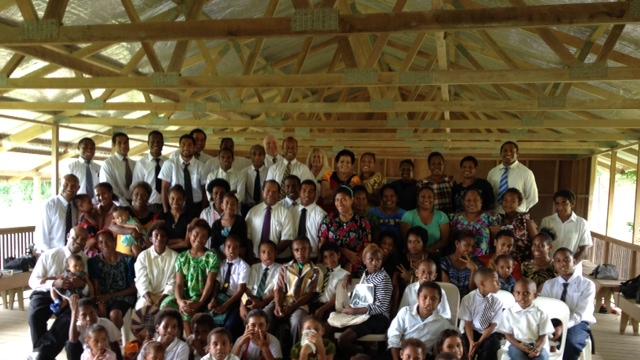Leaders and guests of The Church of Jesus Christ of Latter-day Saints gathered in Port Moresby recently to mark the 35th anniversary of the creation of the first congregation of the Church in Papua New Guinea.
The first branch (congregation) in Papua New Guinea was established in Port Moresby in October 1979. There are now approximately 23,000 Latter-day Saints in the country.
Church leaders, including Elder S. Gifford Nielsen of the Church's Pacific Area Presidency, Elder Jeffrey D. Cummings, President Jonathan Omae, President Mario Amoni, President Pita Hopoate, and President Mark Peteru hosted guests from government, the diplomatic community, business and media sectors at a special dinner in November at the Airways Hotel.
Elder Nielsen told the guests that Latter-day Saints are devoted to Jesus Christ, family and community. He said, “We are here and do what we do because we love the Lord and love our neighbours.”

Members of the 8 Mile Branch in Papua New Guinea.
Elder Jeffrey Cummings, a Pacific Area Seventy for the Church who travels very frequently to the country, told Mormon Newsroom recently about some of the members in PNG.
“The Church was originally established with expat senior couple missionaries running the majority of the programs and holding most of the leadership positions. When the couples were stopped from coming due to safety concerns some 15 years ago, the Church was held together by faithful but inexperienced locals.
“In the past 12 months we have begun to see the return of the senior couple missionaries and this has had a dramatic positive effect where they have taken on the role of mentors and trainers of local leadership. They have also promoted “rescue efforts” in the wards and branches and there has been tremendous growth in those returning to Church activity.”
- 2_-Girabu_Branch_Members
- 3_-_Isumo_Ward_bush_chapel
- 7_-Typical_open_shelter_for_meetings_where_no_chapel_built
- 8_-Walking_on_bush_trak_to_get_to_Korisata_Village
- 4_-Korisata_Chapel
- 6__Daru_settlement
- 5_-_Daru_Settlement_members
| Temple Square is always beautiful in the springtime. Gardeners work to prepare the ground for General Conference. © 2012 Intellectual Reserve, Inc. All rights reserved. | 1 / 2 |
Church members in Papua New Guinea face some unique challenges getting to and from their meetings. Elder Cumming said that in most cases the members walk anything up to two hours to attend Church. In major cities they can catch public transport if they have the fare. For district and stake conferences many have to travel by canoe (often two canoes bound together as a raft). This travel can take anywhere from two hours to two days.
Elder Cummings also commented about their Church meeting places. “In the small villages where we have a branch or group, they would meet in a hut or just gather under a crude shelter of bamboo and sago palm leaves. In more established areas they meet in ‘bush chapels’, which are simple affairs with no external walls. In the main urban centres we have more established buildings.
“PNG has 800 tribes with 800 different languages. There is minimal infrastructure outside the main urban areas. No electricity, no fixed telephone or internet, roads, clean water or sewage.”
He also said that the country, as a whole, was a very Christian nation. People were generally receptive to the Gospel of Jesus Christ. In many areas, it was the only religion in the village.
“Obviously,” he said, “the Church welfare system has been a great advantage to Church members as well as humanitarian initiatives for clean water, food production and disaster relief and recovery which has aided the entire country. The current initiative of self-reliance through education, vocational training and self-employment is the future of the Church, let alone the country”.
At the evening celebration, Port Morseby stake president, Jonathan Omae, announced to guests that the Church will partner with an overseas charity and Papua New Guinea's government in a Measles and Rubella immunisation initiative in 2015.
Elder Nielsen closed the evening by thanking governmental, faith and community leaders for their service to the people of Papua New Guinea, and noted with appreciation the opportunities the Church has had to partner with others to bless individuals, families and communities.
Watch a short film about the Church.